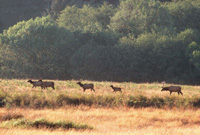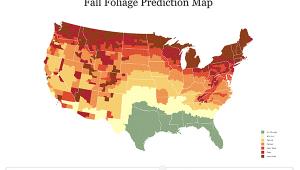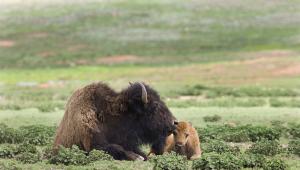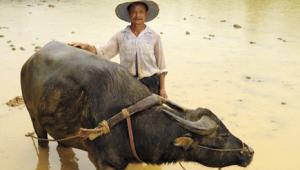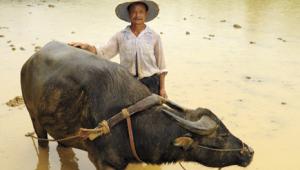Gentle Scenics
Discerning The Less Than Obvious Landscape
America has long fostered the "bigger is better" philosophy of life. Bigger cars, bigger houses, bigger everything. The visual equivalent of this attitude is evident in the movies we attend. Each successive film has to have more car chases, more and bigger explosions, more psychotic screaming and yelling, more blood and gore than the last one, or we're bored. Perhaps the silliest current manifestation of this is that in gunfight scenes, bullet ricochets are no longer just represented by sound; now they all have to spark, even from materials that couldn't possibly produce a spark. Gotta maintain the audience's increasingly short attention span. Still photographers, at least those who shoot mostly scenics, tend to suffer their own version of this "bigger bang" theory. Rather than being appreciative of a wide mix of compositions, many are only looking for the awesomely spectacular. The reddest sunset, the tallest trees, the highest waterfall, the most intimidating mountain, etc., etc. Anything less is below their radar and obviously not worth the waste of film. After all, who's interested in looking at the second or third-ranked waterfall or mountain--number one is where it's at, right? This might be the case for the type of hyperactive, ego-driven photographer who gallops through life with a check list in hand, seeking to match every shot he's ever seen in National Geographic. His or her mainspring is wound too tightly to ever slow down and relax long enough to enjoy the gentler geography that abounds. Fortunately, for most of us, it is possible to acquire an appreciation for the more restful landscape. It's not that erupting volcanoes and splashy sunsets aren't great camera fodder. Rather it's the need to learn the art of visual pacing. |
|||
Visual Overload Other presenters, unfortunately much fewer in number, knew enough to intersperse the thundering waterfalls with babbling brooks and the blazing redrock canyons with pastoral meadows. It's as if your brain was a muscle, tensing and contracting when experiencing the astoundingly dramatic images, relaxing again when served a tranquil scene. Paced in this manner, viewers arrived at the end of the presentation refreshed and ready for more. Recognizing the "gentle" scenic is every bit as much of an art, if not more so, than bagging the "big game." Let's face it; when the image of Half Dome, wreathed in tendrils of fog and aglow with late afternoon light, smacks you between the lookers, it doesn't take a photographic genius to perceive the photo-worthiness of the situation. |
|||
Simpler Pleasures Spectacular renditions of spectacular subjects mainly involve planning and pure dumb luck, in varying percentages. Beyond initial recognition, however, scoring an effective gentle scenic most often depends on your skills at making the most of a variety of compositional elements as you come upon them. Learning to recognize the possibilities is frequently hampered by the average photographer's tendency to immediately discount scenes with less than ideal lighting. Magazine articles, books, and camera gurus have hammered into us the belief that effective photographs are only possible during early morning or late afternoon light, or the "quiet light" or "sweet light" experienced before sunrise or after sunset. While these are certainly desirable lighting conditions, they are fleetingly brief. Limiting yourself to only those times will make you an unnecessarily unproductive photographer. Pause, And Look Some other useful "props" to be alert for include transitory atmospheric elements such as mist, ground fog, and frost, as well as cloud shadows. Each can be an effective, low-key means of breaking up an otherwise blandly uniform scenic tapestry. Experimenting with different lens focal lengths and shooting distances can help extract a successful composition from an inferior lighting situation, as can extremely high or low camera angles. Shallow depth of field can be employed to separate a tranquil foreground from a harsh background. Blurred, wind-induced motion (use a slow shutter speed) of tall grasses and tree branches can add a soothing, abstract element to a photograph, either by itself or as a framing device. Consistent success in rendering the mellow scenic requires less haste in judging scenes that may, at first sight, appear to be a bit too marginal to turn into an effective composition. You'll find that, often as not, a little imagination and improvisation can result in a pleasing image that others overlook. It feels good when another photographer says, "Gee, I walked right by that area twice, but I never saw that picture!" Although learning to see gentle scenics isn't difficult, there's often a fine line separating them from banal record shots. Sometimes you'll just have to accept a situation as a near-miss. You can either pass, or shoot it as best you can, keeping in mind that a little creative help from Photoshop may be all it needs. |
|||
Market Appeal So the next time you're out camera trekking, take enough time to thoroughly assess the possibilities for adding some gentle scenics to your files. When you spot a promising location, stop and explore it right then. Don't figure you'll "get it on the way back." Changes in lighting may erase the quality that previously appealed to you. Plus, the desire to tie on the feed bag and pop a cold one has been known to induce temporary amnesia. What's likely to surprise you is how highly you will come to regard your "noiseless" photos. Long after the novelty has worn off your most dramatic images, you'll still be comfortable with your pictorial quietude. And as the pace of life worldwide becomes increasingly hectic, the more valuable photographs of this ilk will be, both to you and a multitude of others in need of a visual "time out." Recipe For Gentle Scenics
|
- Log in or register to post comments


